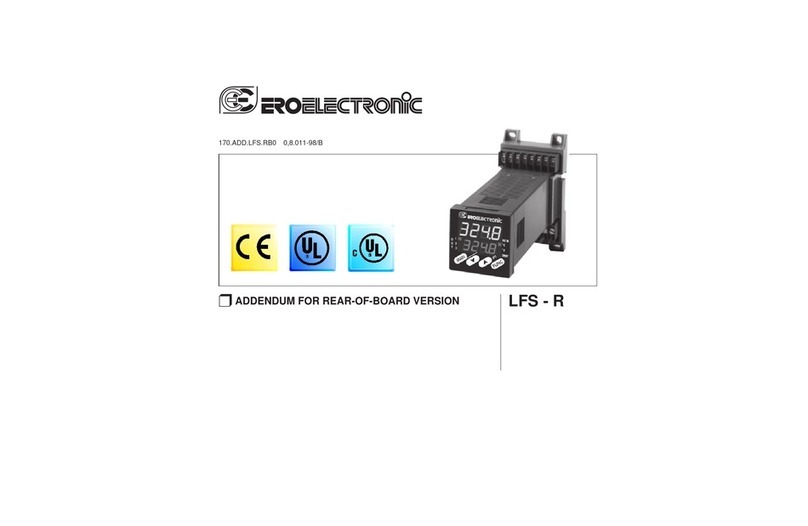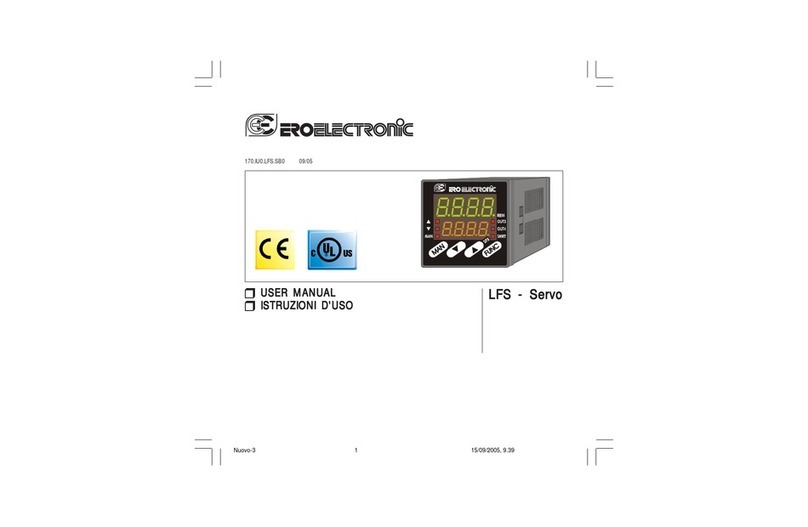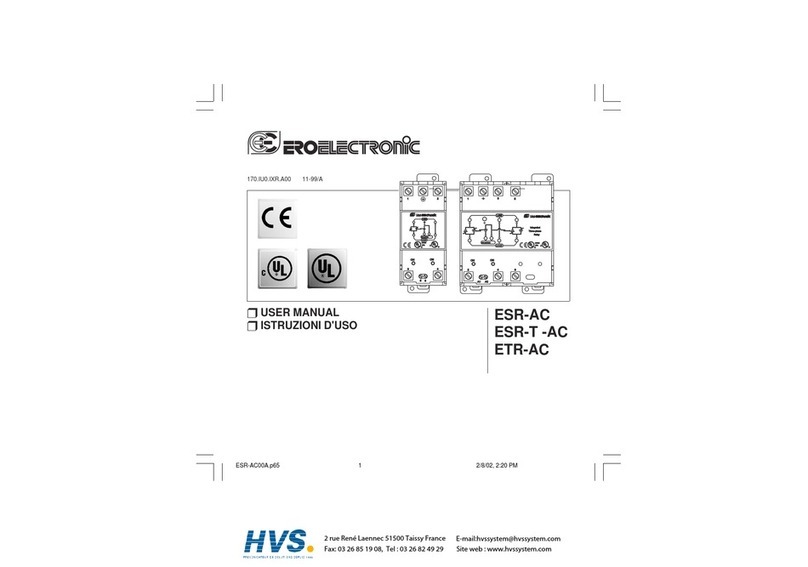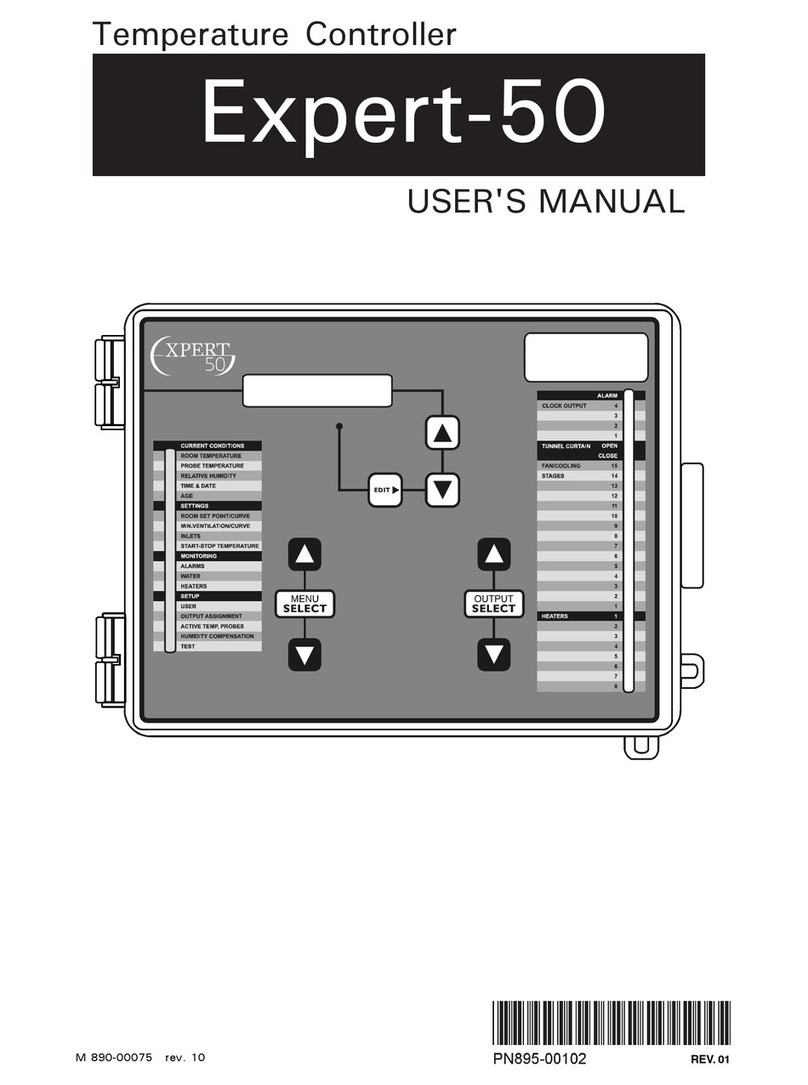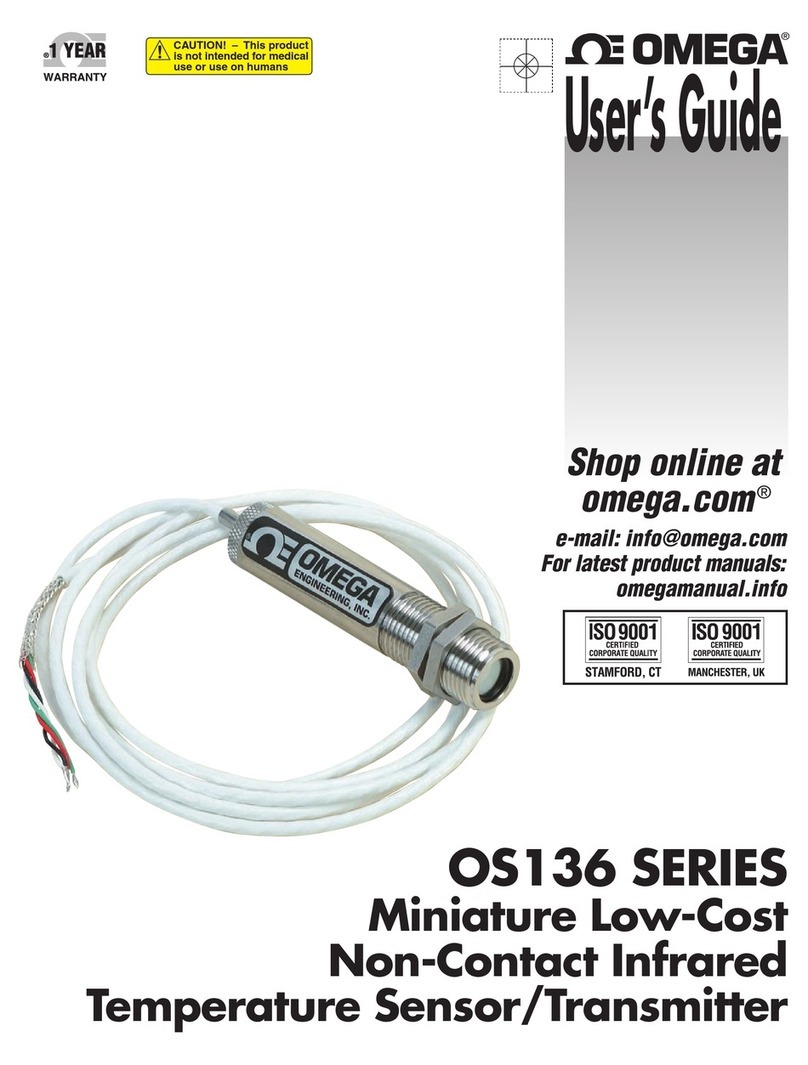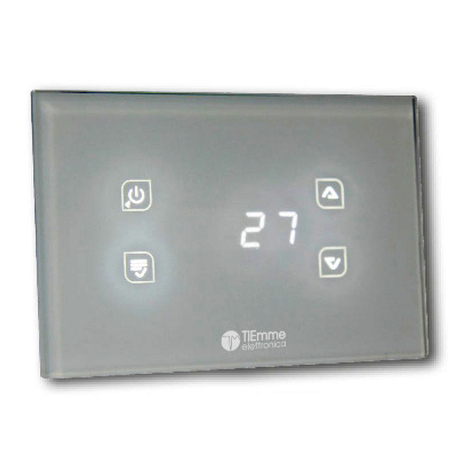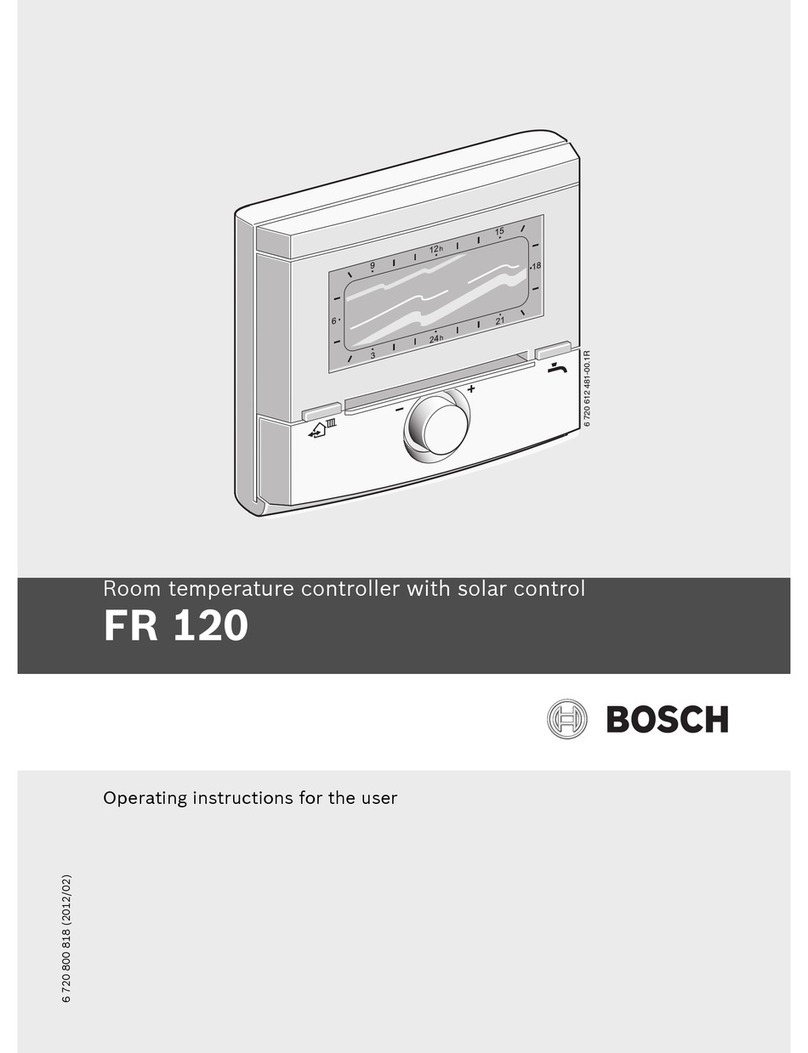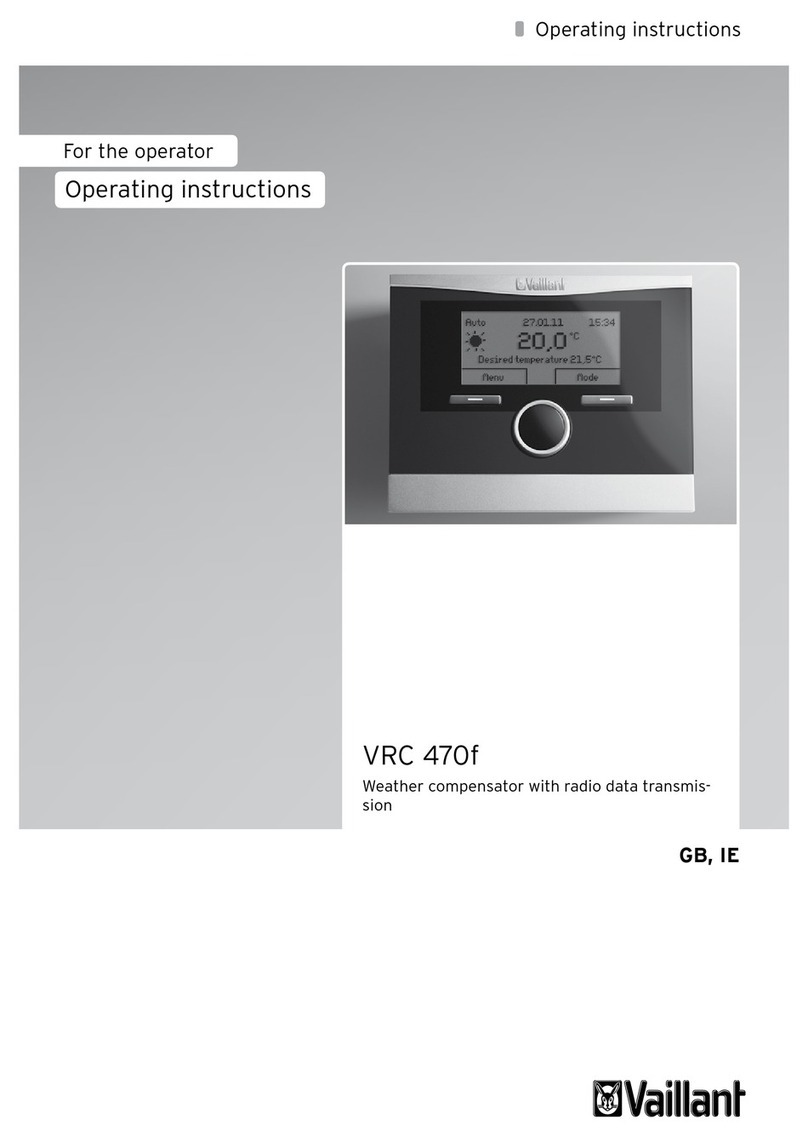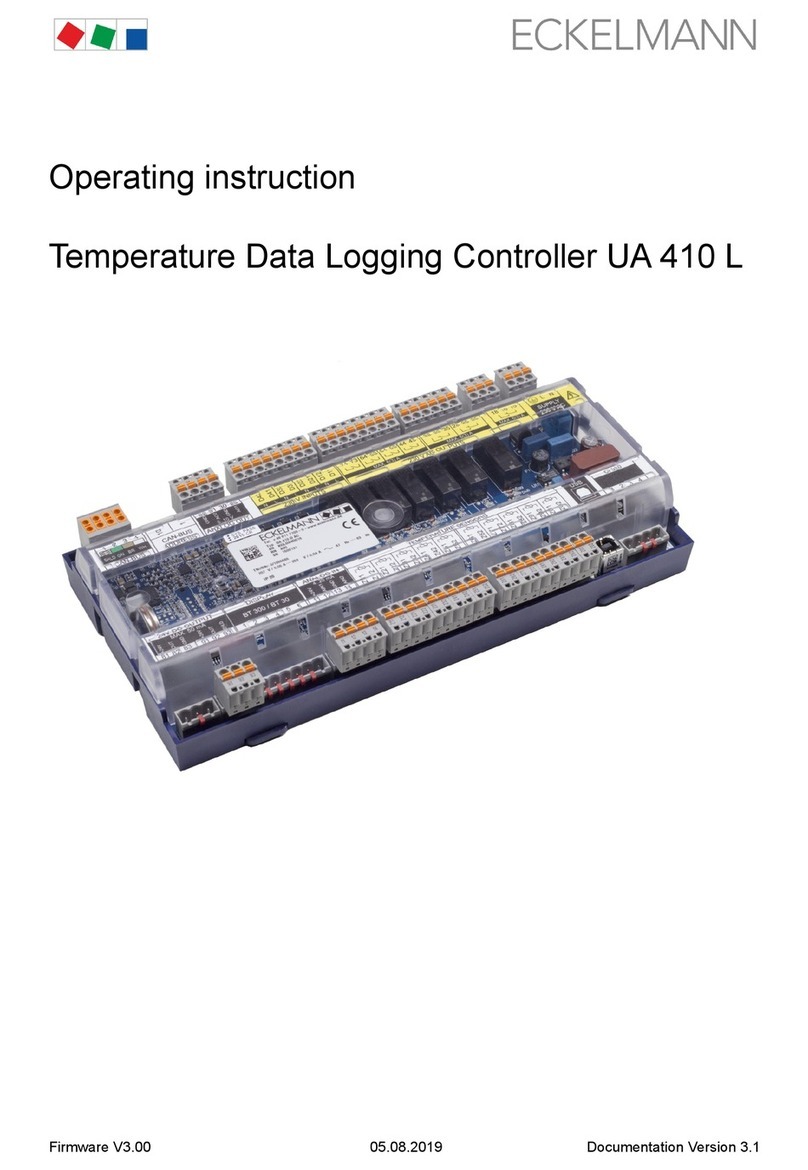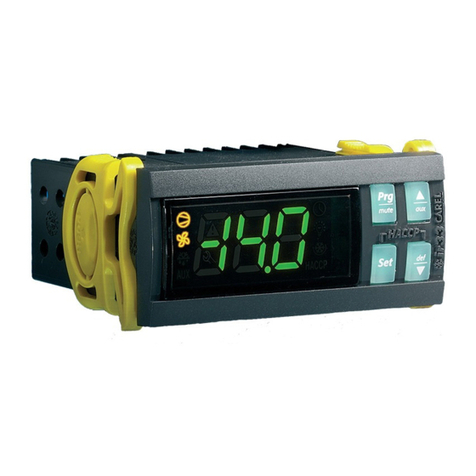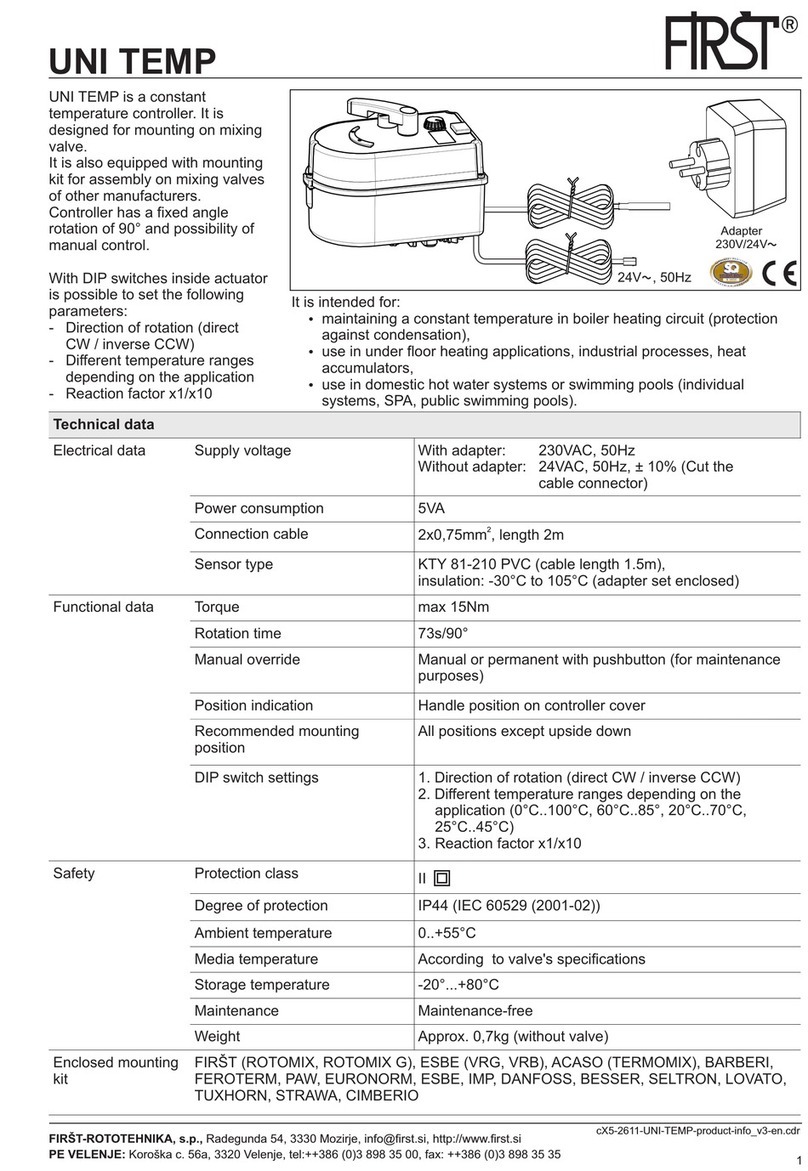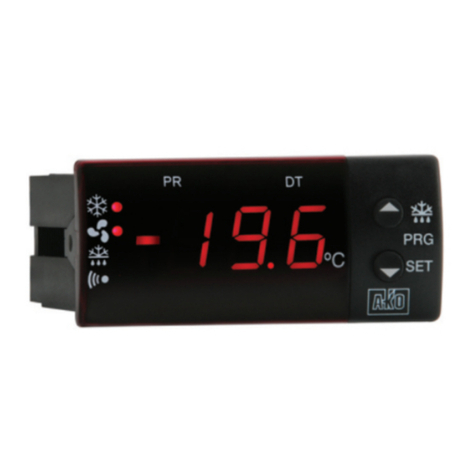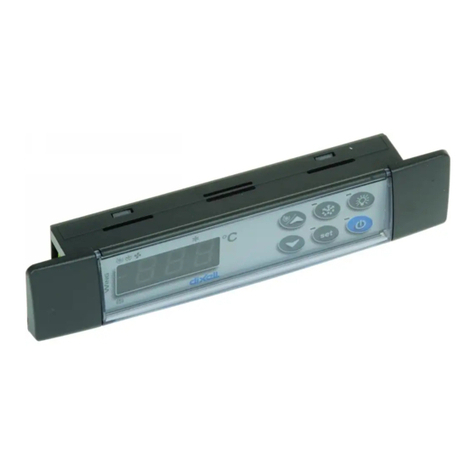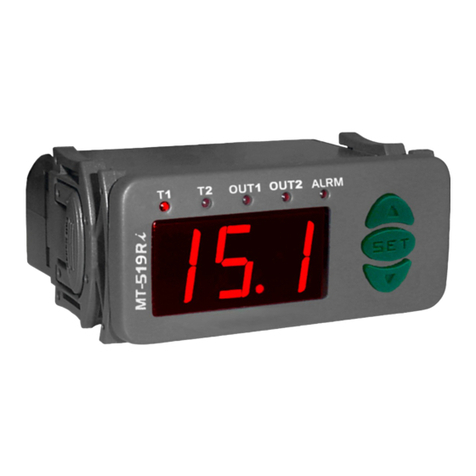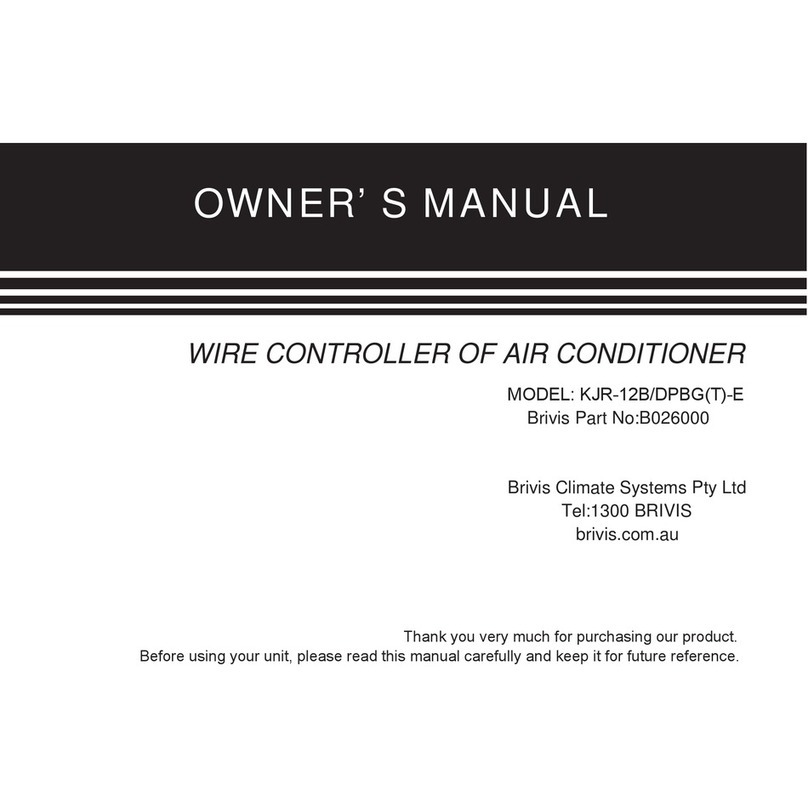ero electronic TMS User manual

UU
UU
UUSER MANUALUSER MANUAL
USER MANUALUSER MANUAL
USER MANUAL
UU
UU
UMANUEL DE SERVICEMANUEL DE SERVICE
MANUEL DE SERVICEMANUEL DE SERVICE
MANUEL DE SERVICE
UU
UU
U
BEDIENUNGSANLEITUNGBEDIENUNGSANLEITUNG
BEDIENUNGSANLEITUNGBEDIENUNGSANLEITUNG
BEDIENUNGSANLEITUNG
UU
UU
UISTRUZIONI D'USOISTRUZIONI D'USO
ISTRUZIONI D'USOISTRUZIONI D'USO
ISTRUZIONI D'USO
TMSTMS
TMSTMS
TMS
170.IU0.TMS.001
TMS-0-01.pmd 16/02/2005, 14.281

INDEXINDEX
INDEXINDEX
INDEX
MOUNTING REQUIREMENTS .......................... 1
DIMENSIONS AND PANEL CUT OUT ............... 2
WIRING GUIDE LINES....................................... 3
PRELIMINARY HARDWARE SETTINGS........... 8
CONFIGURATION PROCEDURE...................... 9
OPERATIVE MODE.......................................... 14
SMART function ........................................ 14
Output power OFF ..................................... 15
Heater break down alarm .......................... 15
Direct access to the set point .................... 16
Lamp test ................................................... 16
OPERATIVE PARAMETERS............................ 16
ERROR MESSAGES........................................ 19
GENERAL INFORMATIONS ............................ 21
DEFAULT PARAMETERS...............................A.1
GBGB
GBGB
GB FF
FF
F
INDEXINDEX
INDEXINDEX
INDEX
MONTAGE.......................................................... 1
DIMENSIONS ET PERCAGE ............................. 2
RACCORDEMENTS ELECTRIQUES ................ 3
MISE AU POINT PRELIMINAIRE....................... 8
PROCEDURES DE CONFIGURATION ............. 9
DIALOGUE UTILISATEUR............................... 14
Algorithme SMART .................................... 15
Invalidation du signal de sortie .................. 15
Alarme de dysfonctionnement ................... 16
Accès direct à la modification directe du
point de consigne ..................................... 16
Lamp Test .................................................. 16
PARAMETRES DE FONCTIONNEMENT ........ 17
MESSAGES D’ERREUR .................................. 19
CARACTERISTIQUES TECHNIQUES............. 21
DEFAULT PARAMETERS...............................A.1
I
TMS-0-01.pmd 16/02/2005, 14.282

INDICEINDICE
INDICEINDICE
INDICE
MONTAGGIO ....................................................... 1
DIMENSIONI E FORATURA ................................. 2
COLLEGAMENTI ELETTRICI ............................... 3
IMPOSTAZIONI HARDWARE PRELIMINARI .... 8
PROCEDURE DI CONFIGURAZIONE............... 9
MODO OPERATIVO......................................... 14
Algoritmo SMART ...................................... 15
Inibizione del segnale di uscita .................. 15
Allarme di malfunzionamento del carico
comandato tramite l'uscita principale ........ 16
Accesso diretto alla modifica
diretta del set point .................................... 16
Lamp Test .................................................. 16
PARAMETRI OPERATIVI................................. 17
MESSAGGI DI ERRORE.................................. 19
CARATTERISTICHE TECNICHE ..................... 21
DEFAULT PARAMETERS...............................A.1
IIIII
DD
DD
D
INHALINHAL
INHALINHAL
INHALTSVERZEICHNISTSVERZEICHNIS
TSVERZEICHNISTSVERZEICHNIS
TSVERZEICHNIS
MONTAGE .......................................................... 1
ABMESSUNGEN UND
FRONTTAFELAUSSCHNITT .............................. 2
ELEKTRISCHE ANSCHLÜSSE.......................... 3
HARDWAREEINSTELLUNGEN ......................... 8
KONFIGURATION............................................... 9
BETRIEBSMODUS........................................... 14
SMART-Algorithmus . ................................ 15
Sperre des Ausgangssignals. .................... 15
Heizleiterbruch-Alarm ................................ 16
Direkte Änderung des Sollwerts ................ 16
Lamp Test .................................................. 16
BETRIEBSPARAMETER .................................. 17
FEHLERMELDUNGEN..................................... 19
TECHNISCHE MERKMALE ............................. 21
DEFAULT PARAMETERS...............................A.1
II
TMS-0-01.pmd 16/02/2005, 14.283

1
GBGB
GBGB
GB
panel
screw
screw
gasket
Fig. 1
MOUNTING REQUIREMENTSMOUNTING REQUIREMENTS
MOUNTING REQUIREMENTSMOUNTING REQUIREMENTS
MOUNTING REQUIREMENTS
Select a mounting location having the following
characteristics:
1) it should be easy accessible also on the rear
side.
2) there is no vibrations or impact
3) there are no corrosive gases (sulphuric gas,
ammonia, etc.).
4) there are no water or other fluid (i.e. condense)
5) the ambient temperature is in accordance with
the operative temperature of the instrument
(from 0 to 50 °C).
6) the relative humidity is in accordance with the
instrument specifications ( 20% to 85 % non
condensing).
The instrument can be mounted on a panel up to
15 mm thick with a square cutout of 45 x 92 mm.
For outline and cutout dimensions refer to Fig. 2.
The surface texture of the panel must be better
than 6,3 µmm.
The instrument is shipped with rubber panel
gasket (50 to 60 Sh).
To assure the IP65 and NEMA 4 protection, insert
the panel gasket between the instrument and the
panel as shown in fig. 1.
While holding the instrument against the panel
proceed as follows:
1) insert the instrument through the panel gasket,
2) insert the instrument, with the panel gasket,
through the panel cut out,
3) while pressing the instrument firmly against the
panel, insert the mounting bracket and slide it
up to the end of the case,
4) with a screwdriver, turn the screws with a
torque between 0.3 and 0.4 Nm,
5) Make sure you cannot move the case within
the cut out otherwise you do not have a NEMA
4X/IP65 protection.
bracket

2
GBGB
GBGB
GB
DIMENSIONS AND PANEL CUT OUTDIMENSIONS AND PANEL CUT OUT
DIMENSIONS AND PANEL CUT OUTDIMENSIONS AND PANEL CUT OUT
DIMENSIONS AND PANEL CUT OUT
Fig. 2

3
GBGB
GBGB
GB
WIRING GUIDELINESWIRING GUIDELINES
WIRING GUIDELINESWIRING GUIDELINES
WIRING GUIDELINES
Connections are to be made with the instrument
housing installed in its proper location.
Fig. 3.A TERMINAL BLOCK (for 100/240 V AC
models)
Fig. 3.B TERMINAL BLOCK (for 24 V AC/DC
models)
A) MEASURING INPUTA) MEASURING INPUT
A) MEASURING INPUTA) MEASURING INPUT
A) MEASURING INPUT
NOTENOTE
NOTENOTE
NOTE: Any external components (like zener
barriers etc.) connected between sensor and
input terminals may cause errors in measurement
due to excessive and/or not balanced line
resistance or possible leakage currents.
THERMOCOUPLE INPUTTHERMOCOUPLE INPUT
THERMOCOUPLE INPUTTHERMOCOUPLE INPUT
THERMOCOUPLE INPUT
Fig. 4 THERMOCOUPLE INPUT WIRING
NOTENOTE
NOTENOTE
NOTE:
1) Don’t run input wires together with power cables.
2) For TC wiring use proper compensating cable
preferably shielded
3) If shielded cable is used, it should be grounded
at one point only.
1
3
+
_
1
3
+
_
Shield
Shield

4
GBGB
GBGB
GB
RTD INPUTRTD INPUT
RTD INPUTRTD INPUT
RTD INPUT
Fig. 5 RTD INPUT WIRING
NOTENOTE
NOTENOTE
NOTE:
1) Don’t run input wires together with power cables.
2) Pay attention to the line resistance; a high line
resistance (higher than 20 Ω/wire) may cause
measurement errors.
3) If shielded cable is used, it should be grounded
at one point only.
4) The resistance of the 3 wires must be the
same.
B) CURRENT TRANSFORMER INPUTB) CURRENT TRANSFORMER INPUT
B) CURRENT TRANSFORMER INPUTB) CURRENT TRANSFORMER INPUT
B) CURRENT TRANSFORMER INPUT
Fig. 6 CURRENT TRANSFORMER INPUT
WIRING
Note:
1) The input impedance is equal to 10 Ω.
2) the maximum input current is equal to 50 mA
(50 / 60 Hz).
4
RTD
13 4
RTD
13
6
7
Current
transformer
Load

5
GBGB
GBGB
GB
3) Use copper conductors only.
4) Don’t run input wires together with power cables.
5) Relay output and SSR drive output are both
available. When a relay output is desired it is
necessary to enable the SSR output and
viceversa (see chapter "Preliminary hardware
settings").
The following recommendations avoid serious
problems which may occur, when using relay
output for driving inductive loads.
INDUCTIVE LOADSINDUCTIVE LOADS
INDUCTIVE LOADSINDUCTIVE LOADS
INDUCTIVE LOADS
High voltage transients may occur when switching
inductive loads.
Through the internal contacts these transients
may introduce disturbances which can affect the
performance of the instrument.
The internal protection (varistor) assures a correct
protection up to 0.5 A of inductive component but
the OUT 1 NC contact and out 3 are not
protected.
The same problem may occur when a switch is
used in series with the internal contacts as shown
in Fig. 8.
Fig. 8 EXTERNAL SWITCH IN SERIES WITH
THE INTERNAL CONTACT
C) RELAY OUTPUTSC) RELAY OUTPUTS
C) RELAY OUTPUTSC) RELAY OUTPUTS
C) RELAY OUTPUTS
Fig. 7 RELAY OUTPUT WIRINGS
The output 2 and the NO contact of the output 1 are
protected, by varistor, from inductive load with an
inductive component up to 0,5 A.
The rating of the out 1 contact is equal to 3A/250
V AC on resistive load.
The rating of the out 2 and 3 contacts is equal to
2A/250 V AC on resistive load.
The number of operations is 1 x 105at specified
rating.
NOTESNOTES
NOTESNOTES
NOTES:
1) To avoid electric shock, connect power line at
the end of the wiring procedure.
2) For power connections use No 16 AWG or larger
wires rated for at last 75 °C.
21
OUT 1 20 C
NO
22 NC
10
11
AL2/HBD
(OUT 3)
C - OUT 3
NO - OUT 3
16
17
AL1/COOL
(OUT 2)
OUT 2
C - OUT 2
NO/NC
[see Fig.11 (J303)]
LOAD
R
CPOWER
LINE

6
GBGB
GBGB
GB
In these cases it is recommended to install an
additional RC network across the external contact
(or close to the non protected contact of the
instrument) as shown in Fig. 8.
The capacity (C) and resistive (R) values are
shown in the following table.
The cable involved in relay output wiring must be
as far away as possible from input or communica-
tion cables.
D) LOGIC OUTPUT FOR SSR DRIVED) LOGIC OUTPUT FOR SSR DRIVE
D) LOGIC OUTPUT FOR SSR DRIVED) LOGIC OUTPUT FOR SSR DRIVE
D) LOGIC OUTPUT FOR SSR DRIVE
Fig. 9 SSR DRIVE OUTPUT WIRING.
These are time proportioning outputs.
Logic level 0Logic level 0
Logic level 0Logic level 0
Logic level 0: Vout < 0.5 V DC.
Logic level 1Logic level 1
Logic level 1Logic level 1
Logic level 1:
- 14 V + 20 % @ 20 mA
- 24 V + 20 % @ 1 mA.
Maximum current = 20 mA.
NOTESNOTES
NOTESNOTES
NOTES:
1) These outputs are not isolated.
A double or reinforced isolation between instru-
ment output and power supply must be assured
by the external solid state relay.
2) Relay output and SSR drive output are both
available. When a SSR output is desired it is
necessary to enable the relay output and
viceversa (see chapter "Preliminary hardware
settings").
LOAD
(mA)
<40 mA
<150 mA
<0.5 A
C
(µF)
0.047
0.1
0.33
R
(Ω)
100
22
47
P.
(W)
1/2
2
2
OPERATING
VOLTAGE
260 V AC
260 V AC
260 V AC
Solid state relay
Solid state relay
_
+
_
+
_
_
+
+
18
19
14
15
OUT 1
OUT 2
(AL1/Cool.)

7
GBGB
GBGB
GB
13
R (S,T)
R (S,T)
N
12 N
Power line
from 100 V to 240 V AC (50/60Hz)
or 24 V AC/DC
E) POWER SUPPLYE) POWER SUPPLY
E) POWER SUPPLYE) POWER SUPPLY
E) POWER SUPPLY
Fig. 10 POWER LINE WIRING
NOTENOTE
NOTENOTE
NOTE:
1) Before connecting the instrument to the power
line, make sure that line voltage corresponds
to the description on the identification label.
2) To avoid electric shock, connect power line at
the end of the wiring procedure.
3) For supply connections use No 16 AWG or larger
wires rated for at last 75 °C.
4) Use copper conductors only.
5) Don’t run input wires together with power cables.
6) For 24 V AC/DC power supply, the input polarity
is a do not care condition.
7) The power supply input has no fuse protection.
Please, provide a fuse type T, 1 A, 250 V
externally.
When fuse is damaged, it is advisable to verify
the power supply circuit, so that it is necessary to
send back the instrument to your supplier.
8) The safety requirements for Permanently
Connected Equipment say:
- a switch or circuit-breaker shall be included in
the building installation;
- It shall be in close proximity to the equipment
and within easy reach of the operator;
- it shall be marked as the disconnecting
device for the equipment.
NOTENOTE
NOTENOTE
NOTE: a single switch or circuit-breaker can drive
more than one instrument.
9) When a neutral line is present, connect it to
terminal 12.

8
GBGB
GBGB
GB
PRELIMINARY HARDWAREPRELIMINARY HARDWARE
PRELIMINARY HARDWAREPRELIMINARY HARDWARE
PRELIMINARY HARDWARE
SETTINGSSETTINGS
SETTINGSSETTINGS
SETTINGS
1) Remove the instrument from its case.
2) For out 1 and 2 it is possible to select the
desired output type by setting the J304 and J305
jumpers.
J304 (AL1, Cool.) 1-2 = SSR 2-3 = Relay
J305 (OUT 1) 1-2 = SSR 2-3 = Relay
3) For out 2 it is possible to select the used relay
contact (NO or NC) by setting J303 jumper.
J303 (AL1, Cool.) 1-2 = Out NO 2-3 = Out NC
NoteNote
NoteNote
Note : J303 is a soldering jumper and it is located
on the soldering side of the card.
Fig 11
OPEN INPUT CIRCUITOPEN INPUT CIRCUIT
OPEN INPUT CIRCUITOPEN INPUT CIRCUIT
OPEN INPUT CIRCUIT
These device are capable to detect leads break
for TC and RTD inputs. For RTD input it shows
this status as an overrange condition.
For thermocouple input only, it is possible, to
select the overrange indication (standard) by
closing CH2 and opening SH2 or underrange
indication by closing SH2 and opening CH2.
SH2 and CH2 are located on the soldering side of
the CPU card (see fig.12).
Fig. 12
1
1
1
23
4
+
-
+
B
C
E
I
1
3
4
7
1
1
XY00
I
1
2
3
12
3
45
12
345
J301
J302
L305
R301
R303
D305
C308
C306
C307
R305
C312
C310
D307
R308
C309
PZ12 PZ13
PZ14 PZ15
PZ16
PZ19
PZ20 PZ21 PZ22
R307
R306
Q302
U302
TR301
J304
J305
Y301
D306
D308
D304
U301
PZ18
PZ17
C301
C304
J303
C303
C311
C302 C305
C314
C313
L304 L301
L303
L302
R309
R310
R312
R314
R311 R302
R304
R313
Q303
Q305
D302
Q301
Q304
D301
D310
K302
K301
J 303
1
1
3
J304 J305
CH2
SH2

9
GBGB
GBGB
GB
GENERAL NOTES for configuration.GENERAL NOTES for configuration.
GENERAL NOTES for configuration.GENERAL NOTES for configuration.
GENERAL NOTES for configuration.
FUNC = This will memorize the new value of
the selected parameter and go to the
next parameter (increasing order).
SMRT = This will scroll back the parameters
without memorization of the new value.
= This will increase the value of the
selected parameter
= This will decrease the value of the
selected parameter.
CONFIGURATION PROCEDURECONFIGURATION PROCEDURE
CONFIGURATION PROCEDURECONFIGURATION PROCEDURE
CONFIGURATION PROCEDURE
1) Remove the instrument from its case.
2) Set the internal switch V2 in open condition
Fig.13
3) Re-insert the instrument..
4) Switch the instrument “ON”.
The display will show COnF.
NOTENOTE
NOTENOTE
NOTE : If “CAL” indication is displayed, press
immediately the push-button to return to the
configuration procedure.
5) Push the FUNC push-button.
The instrument will show on the lower display
the parameter code and on the upper display
the actual parameter value.
P1 - Input type and standard rangeP1 - Input type and standard range
P1 - Input type and standard rangeP1 - Input type and standard range
P1 - Input type and standard range
0 = TC type L range 0 / +800 °C
1 = TC type J range 0 / +800 °C
2 = TC type K range 0 / +999 °C
3 = TC type N range 0 / +999 °C
4 = RTD type Pt 100 range -199 / +500 °C
5 = RTD type Pt 100 range -19.9 /+99.9 °C
6 = TC type T range 0 / +400 °C
8 = TC type L range 0 / +999 °F
9 = TC type J range 0 / +999 °F
10 = TC type K range 0 / +999 °F
11 = TC type N range 0 / +999 °F
12 = RTD type Pt 100 range -199 / +999 °F
13 = TC type T range 0 / +752 °F
P2 = Initial scale valueP2 = Initial scale value
P2 = Initial scale valueP2 = Initial scale value
P2 = Initial scale value
Not present when P1 = 5
Initial scale value used by the PID algorithm to
calculate the input span.
P2 is programmable within the input span
selected by P1.
When P2 has been modified, the instrument
assignes to the rL parameter the new P2 value.
V2

10
GBGB
GBGB
GB
P3 = Full scale valueP3 = Full scale value
P3 = Full scale valueP3 = Full scale value
P3 = Full scale value
Not present when P1 = 5
Full scale value used by the PID algorithm to
calculate the input span.
P3 is programmable within the input span
selected by P1.
When P3 has been modified, the instrument
assignes to the rH parameter the new P3 value.
NOTENOTE
NOTENOTE
NOTE: the minimum input span (P3 - P2) is
- 300 °C or 600 °F for TC input
- 100 °C or 200 °F for RTD input.
P4 = Output configurationP4 = Output configuration
P4 = Output configurationP4 = Output configuration
P4 = Output configuration
H = heating
HC = heating/cooling
P5 = Main output typeP5 = Main output type
P5 = Main output typeP5 = Main output type
P5 = Main output type
rEL = Relay output.
SSr = SSR output.
NOTENOTE
NOTENOTE
NOTE:
Setting P5 = rEL, the C parameter will be
automatically set to 20 s.
Setting P5=SSr, the C parameter will be
automatically set to 2 s.
P6 = Cooling output typeP6 = Cooling output type
P6 = Cooling output typeP6 = Cooling output type
P6 = Cooling output type
Available only when P4 = HC
AIr = air
OIL = oil
H2O = water
NOTENOTE
NOTENOTE
NOTE:
Setting P6 = Air, the C2 parameter will be
automatically set to 10 s
and rC parameter will be
set to 1.00.
Setting P6=OiL, the C2 parameter will be au-
tomatically set to 4 s and rC
parameterwillbe setto0.80.
Setting P6=H2O, the C2 parameter will be au-
tomatically set to 2 s and rC
parameterwillbe setto0.40.
P7 = Alarm 1P7 = Alarm 1
P7 = Alarm 1P7 = Alarm 1
P7 = Alarm 1
Available only when P4 = H.
0 = Not provided
1 = Process alarm
2 = Band alarm
3 = Deviation alarm
P8 = Alarm 1 operative modeP8 = Alarm 1 operative mode
P8 = Alarm 1 operative modeP8 = Alarm 1 operative mode
P8 = Alarm 1 operative mode
Available only when P7 is different from 0 and
P4 = H.
H.A = high alarm (outside band) with automatic
reset
L.A = low alarm (inside band) with automatic reset
H.L= high alarm (outside band) with manual reset
L.L= low alarm (inside band) with manual reset
P9 = Stand by (mask) of the alarm 1P9 = Stand by (mask) of the alarm 1
P9 = Stand by (mask) of the alarm 1P9 = Stand by (mask) of the alarm 1
P9 = Stand by (mask) of the alarm 1
Available only when P7 is different from 0 and
P4 = H. OFF = stand by (mask) disabled
ON = stand by (mask) enabled
NOTENOTE
NOTENOTE
NOTE: the alarm stand by function allows to
disable the alarm indication at instrument start up
or, for band and deviation alarms, after a set point
modification.
The alarm will be automatically reactivated when
the initial alarm condition disappears.

11
GBGB
GBGB
GB
P10 = Alarm 2P10 = Alarm 2
P10 = Alarm 2P10 = Alarm 2
P10 = Alarm 2
0 = Not provided
1 = Process alarm
2 = Band alarm
3 = Deviation alarm
Alarm 2 and HBD functions are in OR condition
on the output 3 (see P16 parameter).
P11 = Alarm 2 operative mode and reset of theP11 = Alarm 2 operative mode and reset of the
P11 = Alarm 2 operative mode and reset of theP11 = Alarm 2 operative mode and reset of the
P11 = Alarm 2 operative mode and reset of the
HBD alarm.HBD alarm.
HBD alarm.HBD alarm.
HBD alarm.
Available only when P10 is different from 0 or P16
is different from OFF.
H.A = high alarm (outside band) with
automatic reset
L.A = low alarm (inside band) with automatic reset
H.L= high alarm (outside band) with manual reset
L.AL= low alarm (inside band) with manual reset
NOTENOTE
NOTENOTE
NOTE: The HBD alarm is a low alarm but it
assumes the same reset type selected for
alarm 2.
P12 = Stand by (mask) of the alarm 2P12 = Stand by (mask) of the alarm 2
P12 = Stand by (mask) of the alarm 2P12 = Stand by (mask) of the alarm 2
P12 = Stand by (mask) of the alarm 2
Available only when P10 is different from 0.
OFF = stand by (mask) disabled
ON = stand by (mask) enabled
For other details see P9 parameter.
P13 = Type of OFFSET applied to theP13 = Type of OFFSET applied to the
P13 = Type of OFFSET applied to theP13 = Type of OFFSET applied to the
P13 = Type of OFFSET applied to the
measured valuemeasured value
measured valuemeasured value
measured value
P13 = 0 the OFFSET (P14) is
constant all over the range.
P13 different from 0P13 is the application point of
the OFFSET selected by P14
parameter.
NOTENOTE
NOTENOTE
NOTE: the P13 and P14 parameters do not
modify the measuring or read-out limits of the
instrument so that when one of this limit has been
exceeded, the instrument will show an out of
range condition.
P14 = OFFSET valueP14 = OFFSET value
P14 = OFFSET valueP14 = OFFSET value
P14 = OFFSET value
When P13 = 0, P 14 is programmable, in
engineering units, from -20% to
+ 20% of the input span (see
P1).
When P13 ≠0 P14 is programmable, in
engineering units, from -20% to
+ 20% of the P13 value.
NOTENOTE
NOTENOTE
NOTE: the P14 parameter can not be set lower
than -199 units.
P15 = Threshold of the “Soft Start” function.P15 = Threshold of the “Soft Start” function.
P15 = Threshold of the “Soft Start” function.P15 = Threshold of the “Soft Start” function.
P15 = Threshold of the “Soft Start” function.
Threshold value, in engineering units, used by the
instrument for automatic enabling of the "soft
start" function (timed output power limiting).
At instrument start up, if the measured value is
lower than the programmed threshold value, the
instrument will automatically enable the output
power limiter (see OLH parameter) and it
maintains this limit for a time programmed by tOL
parameter.
At instrument start up, if the tOL parameter is
equal to "InF", the P15 setting has no effect.
P13 = 0
Readout.
Adjusted
curve
Input
P14
Real
curve
P13
Readout.
P14
Input
Real
curve
Adjusted
curve

12
GBGB
GBGB
GB
P16 =P16 =
P16 =P16 =
P16 = Measure of the current consumed byMeasure of the current consumed by
Measure of the current consumed byMeasure of the current consumed by
Measure of the current consumed by
the load driven by the main outputthe load driven by the main output
the load driven by the main outputthe load driven by the main output
the load driven by the main output
(HBD)(HBD)
(HBD)(HBD)
(HBD)
OFF = measure disabled
n.O. = measure enabled during the ON period
(logic status 1 for SSR output or contact
NO for relay output)
n.C. = measure enabled during the OFF period
(logic status 0 for SSR output or contact
NC for relay output)
P17 =P17 =
P17 =P17 =
P17 =Full scale of the current transformer.Full scale of the current transformer.
Full scale of the current transformer.Full scale of the current transformer.
Full scale of the current transformer.
Available only when P16 is different from OFF.
10 = 10 A (resolution: 0.1 A)
25 = 25 A (resolution: 1 A)
50 = 50 A (resolution: 1 A)
100 = 100 A (resolution: 1 A)
P18 = Safety lockP18 = Safety lock
P18 = Safety lockP18 = Safety lock
P18 = Safety lock
0 = device unlocked. All the parameters can be
modified
1 = device locked. No one parameters can be
modified exception made for SP.
From 2 to 499 = during operative mode, SP
parameter can be modified and
this number allows to enable/
disable the modification of all the
other parameters.
From 500 to 999 = SP, A1 and A2 parameters
can be modified and this number
allows to enable/disable the
modification of all the other
parameters.
NOTENOTE
NOTENOTE
NOTE: After FUNC push-button pressure it will be
impossible to display this value again. If you don't
remember the old key, set a new value.
The configuration procedure is completed and the
instrument will show " -.-.-." on both displays.
When it is desired to end the configuration
procedure push the FUNC push-button; the
display will show "COnF".
When it is desired to access to the advanced
configuration parameter, proceed as follows:
1) using and push-button set the 217 code.
2) push the FN push-button; the instrument will
start the auxiliary configuration procedure and
it will show the following additional param-
eters.
P19 - Main output actionP19 - Main output action
P19 - Main output actionP19 - Main output action
P19 - Main output action
Available only when P4 = H.
r = Reverse (heating)
d = direct (cooling)
NoteNote
NoteNote
Note : when P4 = HC, this parameter is
equal to "r".
P21 - Alarm 1 output actionP21 - Alarm 1 output action
P21 - Alarm 1 output actionP21 - Alarm 1 output action
P21 - Alarm 1 output action
Available only when P7 is different from 0 and P4
is equal to H.
r = reverse (relay de-energized in alarm
condition).
d = Direct (relay energized in alarm condition)
t
Input
t
Output t
Input
t
Output
Reverse Direct

13
GBGB
GBGB
GB
P22 - Alarm 2 output actionP22 - Alarm 2 output action
P22 - Alarm 2 output actionP22 - Alarm 2 output action
P22 - Alarm 2 output action
Available only when P10 is different from 0 and
P16 is different from "OFF".
r = reverse (relay de-energized in alarm
condition).
d = Direct (relay energized in alarm condition)
P23 - Automatic modification of the "relativeP23 - Automatic modification of the "relative
P23 - Automatic modification of the "relativeP23 - Automatic modification of the "relative
P23 - Automatic modification of the "relative
cooling gain"cooling gain"
cooling gain"cooling gain"
cooling gain"
Available only when P4=HC.
OFF = The SMART function will NOTNOT
NOTNOT
NOT modify
the "relative cooling gain" parameter
value.
ON = The SMART function will modify the
"relative cooling gain" parameter value.
P24 - Control output maximum rate of riseP24 - Control output maximum rate of rise
P24 - Control output maximum rate of riseP24 - Control output maximum rate of rise
P24 - Control output maximum rate of rise
This parameter allows to set the maximum rate of
rise of the control output.
It is programmable from 1 to 10 % of the output
signal per second.
Setting a value greater then 10%/s the upper
display will blank and no limit is applied.
P25 - Display of the protect parameterP25 - Display of the protect parameter
P25 - Display of the protect parameterP25 - Display of the protect parameter
P25 - Display of the protect parameter
enabling/disabling.enabling/disabling.
enabling/disabling.enabling/disabling.
enabling/disabling.
Available only when P18 is different from 0.
OFF = protected parameter cannot be displayed
ON = protected parameter can be displayed
P26 - SMART function enabling/ disablingP26 - SMART function enabling/ disabling
P26 - SMART function enabling/ disablingP26 - SMART function enabling/ disabling
P26 - SMART function enabling/ disabling
0 = The SMART function is disabled
1 = The SMART function enabling/disabling
is NOTNOT
NOTNOT
NOT protected by the safety key.
2 = The SMART function enabling/disabling
is protected by the safety key.
P27 - Maximum value of the proportional bandP27 - Maximum value of the proportional band
P27 - Maximum value of the proportional bandP27 - Maximum value of the proportional band
P27 - Maximum value of the proportional band
settable by the SMART functionsettable by the SMART function
settable by the SMART functionsettable by the SMART function
settable by the SMART function
Available only when P26 is different from 0.
This parameter may be programmed from P28 or
P29 value to 99.9.
P28 - Minimum value of the proportional bandP28 - Minimum value of the proportional band
P28 - Minimum value of the proportional bandP28 - Minimum value of the proportional band
P28 - Minimum value of the proportional band
settable by the SMART functionsettable by the SMART function
settable by the SMART functionsettable by the SMART function
settable by the SMART function
Available only when P4=H and P26 is different
from 0.
This parameter may be programmed from 1.0 %
to P27 value.
P29 - Minimum value of the proportional bandP29 - Minimum value of the proportional band
P29 - Minimum value of the proportional bandP29 - Minimum value of the proportional band
P29 - Minimum value of the proportional band
settable by the SMART function in heating/settable by the SMART function in heating/
settable by the SMART function in heating/settable by the SMART function in heating/
settable by the SMART function in heating/
cooling control onlycooling control only
cooling control onlycooling control only
cooling control only
Available only when P4=HC and P26 is different
from 0.
This parameter may be programmed from 1.5 %
to P27 value.
P30 - Minimum value of integral time settableP30 - Minimum value of integral time settable
P30 - Minimum value of integral time settableP30 - Minimum value of integral time settable
P30 - Minimum value of integral time settable
by SMART function.by SMART function.
by SMART function.by SMART function.
by SMART function.
Available only when P26 is different from 0.
This parameter may be programmed from 00.1
(mm.s) to 02.0 (mm.s).
P31 - Extension of the anti-reset-wind upP31 - Extension of the anti-reset-wind up
P31 - Extension of the anti-reset-wind upP31 - Extension of the anti-reset-wind up
P31 - Extension of the anti-reset-wind up
Range: from -30 to +30 % of the proportional
band.
NOTENOTE
NOTENOTE
NOTE: a positive value increases the high limit of
the anti-reset-wind up (over set point) while a
negative value decreases the low limit of the anti-
reset-wind up (under set point).
The auxiliary configuration is finished and the
instrument will show "CnF" on the upper display.

14
GBGB
GBGB
GB
OPERATIVE MODEOPERATIVE MODE
OPERATIVE MODEOPERATIVE MODE
OPERATIVE MODE
1) Remove the instrument from its case.
2) Set the V2 jumper (see fig. 13) in close
condition.
3) Re-insert the instrument.
4) Switch on the instrument.
The upper display will show the measured value
while the lower display will show the programmed
set point (we define this display condition as
“normal display mode”).
NoteNote
NoteNote
Note: When a ramp is applied to the set point value
(see rP parameter), the displayed set point
value may be different from the operative set
point.
When the HBD function is configured, the control
output is enabled and the instrument is in normal
display mode, pushing the push-button the
lower display will show the current, followed by
the "A" symbol, consumed by the load driven by
the main output.
NOTENOTE
NOTENOTE
NOTE: the time out has no effect on this
indication.
When it is desired to come back to the normal
display mode, push the push-button again.
SMART functionSMART function
SMART functionSMART function
SMART function
The SMART algorithm is a NEW self-tuning
function of the instrument. It is used by the
instrument to calculate and set automatically the
control parameters.
The SMART algorithm may be ever operative; in
this case it will adapt continuously the control
parameter in order to perform the best control
action.
To start "SMART" function, depress the SMRT
push-button for more than 1.5 seconds when the
instrument is in NORMAL DISPLAY MODE, the
SMRT indicator will start blinking or lighting
according to the special function performing.
When it is desired to disable the SMART function,
push the SMRT push-button again, the SMRT
indicator will turn to OFF.
NOTESNOTES
NOTESNOTES
NOTES:
1) During the SMART function operation, the
relative cooling gain (if present) is limited within
the following ranges:
Cooling element range
Air 0.85 to 1.00
OIL 0.80 to 0.90
H2O 0.30 to 0.60
2) The SMART function use a derivative action
equal to 1/4 of the integral action.
3) The limits of the proportional band and of the
integral time settable by the SMART function
are programmed by P27, P28, P29 and P30
parameter.
4) The enabling/disabling of the SMART function
may be under safety key protection.
5) When SMART function is enabled, it is
impossible to modify the Pb, ti and td
parameter; for rC parameter see P23
parameter.

15
GBGB
GBGB
GB
HEATER BREAK DOWN ALARMHEATER BREAK DOWN ALARM
HEATER BREAK DOWN ALARMHEATER BREAK DOWN ALARM
HEATER BREAK DOWN ALARM
This alarm allows to verify, continuously, the
current consumed by the load driven by the main
output and generates an alarm condition when
this current is lower than a programmable
threshold.
To display the main load consumption, push the
push-button when the instrument is in
NORMAL DISPLAY MODE.
The upper display will show the measured value
while the lower display will show the main load
consumption (in Ampere) followed by the
engineering unit (A).
To come back to the normal display mode, push
the push-button.
When an alarm condition is detected, the LED
AL2/HB will be flashing and the relay of the out 3
(alarm 2 OR heater break down alarm) will be
activated.
OUTPUT POWER OFFOUTPUT POWER OFF
OUTPUT POWER OFFOUTPUT POWER OFF
OUTPUT POWER OFF
The TMS allows to turn OFF manually the output
signal in order to stop the control (the instrument
will operate as an indicator only).
To turn OFF the output signal proceed as follows:
1) push and maintain the pressure on the
push-button
2) push FUNC push-button.
3) Maintaining the pressure on both push-buttons
for more than 3 seconds; the lower display will
show "OFF" and the output signal will be
inhibited.
When it is desired to come back to the normal
control, repeat the actions 1, 2 and 3; the
instrument goes automatically to the NORMAL
DISPLAY MODE.
NOTE:NOTE:
NOTE:NOTE:
NOTE: 1)The instrument memorizes the output
status.
2)If the output is turned OFF when the
SMART function was performing the first
part of the algorithm (LED SMRT is
flashing), the SMART function will be
aborted and when the instrument comes
back to the normal control, the SMART
function will be disabled.
If the output is turned OFF when the
SMART function was performing the
adaptive part of the algorithm (LED
SMRT is lit), the SMART function will be
stopped and, when the instrument
comes back to the normal control, the
smart function also will be activated.

16
GBGB
GBGB
GB
DIRECT ACCESS TO THE SET POINTDIRECT ACCESS TO THE SET POINT
DIRECT ACCESS TO THE SET POINTDIRECT ACCESS TO THE SET POINT
DIRECT ACCESS TO THE SET POINT
MODIFICATIONMODIFICATION
MODIFICATIONMODIFICATION
MODIFICATION
The instrument allows to modify the set point
value without to use the FUNC push-button.
When a rapid set point modification is required,
proceed as follows:
1) Pushing, for more than 3 seconds, the or
push-button; the set point value, shown on
the lower display, will start to change.
2) Using the and push-buttons, it is
possible to set the desired value.
3) When the desired value is reached, do not
push any push-button for more than 3
seconds, the new set point will become
operative after 3 seconds from the last push-
button pressure.
If, during this procedure, it is desired to lose the
new value, push the FUNC push-button; the
instrument automatically returns to the normal
display mode without to memorize the new set
point.
LAMP TESTLAMP TEST
LAMP TESTLAMP TEST
LAMP TEST
When it is desired to verify the display efficiency,
push and FUNC push-buttons. The instrument
will turn ON, with a 50 % duty cycle, all the LED
of the display (we define this function "LAMP
TEST").
No time out is applied to the LAMP TEST.
When it is desired to come back to the normal
display mode, push and FUNC push-buttons
again.
No other keyboard function is available during
LAMP TEST.
OPERATIVE PARAMETERSOPERATIVE PARAMETERS
OPERATIVE PARAMETERSOPERATIVE PARAMETERS
OPERATIVE PARAMETERS
Operative parameter modificationOperative parameter modification
Operative parameter modificationOperative parameter modification
Operative parameter modification
Push the FUNC push-button, the lower display
will show the code while the upper display will
show the value or the status (ON or OFF) of the
selected parameter.
By or push-button it is possible to set the
desired value or the desired status.
Pushing the FUNC push-button, the instrument
memorizes the new value (or the new status) and
goes to the next parameter.
A pressure of the SMRT push-button allows to come
back to the previous parameter without to memorize
the new set of the actual parameter.
Some parameters may be not visualized according
to the specific instrument configuration.
NOTENOTE
NOTENOTE
NOTE: 1) If, during operative parameter
modification, no push-button is
pressed for more than 10 seconds,
the instrument reverts automatically
to the “normal display mode” without
to memorize the last parameter
setting.
2) The instrument do not display all
parameter but it select the
parameter in accordance with:
a) the instrument configuration
b) P25 setting
c) the proportional band setting.

17
GBGB
GBGB
GB
Param.Description
SP Main set pointMain set point
Main set pointMain set point
Main set point
Range: from rL to rH.
n.rS Manual reset of the alarmsManual reset of the alarms
Manual reset of the alarmsManual reset of the alarms
Manual reset of the alarms
This parameter is available only when one
alarm with manual reset has been
programmed.
Set ON and push the FUNC push-button
to reset the alarms.
nnn Software key for parameter protectionSoftware key for parameter protection
Software key for parameter protectionSoftware key for parameter protection
Software key for parameter protection.
This parameter is skipped if P18 = 0 or 1.
The instrument will shows the safety key
status:
ON = the instrument is in LOCK condition
OFF = the instrument is in UNLOCK
condition
When it is desired to switch from LOCK to
UNLOCK condition, set a value equal to
P18 parameter
When it is desired to switch from UNLOCK
to LOCK condition, set a value different
from P18 parameter.
A1 Alarm 1 threshold valueAlarm 1 threshold value
Alarm 1 threshold valueAlarm 1 threshold value
Alarm 1 threshold value
This parameters is present if the alarm 1
is configured only.
Ranges:
- From P2 to P3 for process alarm.
- From 0 to 500 units for band alarm.
- From -199 to 500 units for deviation
alarm.
A2 Alarm 2 threshold valueAlarm 2 threshold value
Alarm 2 threshold valueAlarm 2 threshold value
Alarm 2 threshold value
For other details see A1 parameter.
H1 Alarm 1 hysteresisAlarm 1 hysteresis
Alarm 1 hysteresisAlarm 1 hysteresis
Alarm 1 hysteresis
This parameters is present if the alarm 1
is configured only.
Range: From 0.1% to 10.0% of the input
span or 1 LSD.
NoteNote
NoteNote
Note: If the hysteresis of a band alarm is
larger than the alarm band, the instrument
will use an hysteresis value equal to the
programmed band minus 1 digit.
H2 Alarm 2 hysteresisAlarm 2 hysteresis
Alarm 2 hysteresisAlarm 2 hysteresis
Alarm 2 hysteresis
For other details see H1 parameter.
Pb Proportional band.Proportional band.
Proportional band.Proportional band.
Proportional band.
Range::
::
: from 1.0 % to 99.9 % of span for
heating output.
From 1.5 % to 99.9 % of span for heating/
cooling output.
When Pb parameter is set to 0, the
instrument performs an ON-OFF control;
the ti, td, IP, C, C2, rC, OLP, OLH and
tOL parameters are skipped and SMART
function is disabled.
NoteNote
NoteNote
Note: When SMART is enabled, the Pb
parameter range is limited by P27, P28 and
P29 parameters.
HS Hysteresis for ON/OFF control actionHysteresis for ON/OFF control action
Hysteresis for ON/OFF control actionHysteresis for ON/OFF control action
Hysteresis for ON/OFF control action
It is available only when Pb=0.
Range: from 0.1% to 10.0% of the input
span.
ti Integral timeIntegral time
Integral timeIntegral time
Integral time
"ti" is skipped if Pb=0 (ON/OFF action).
Range: from 00.1 to 20.0 [mm.ss]. Above
this value the display blanks and integral
action is excluded
NoteNote
NoteNote
Note: When SMART is enabled, the mini-
mum value of the integral time is limited by
P30 parameter.
td Derivative timeDerivative time
Derivative timeDerivative time
Derivative time
"td" is skipped if Pb=0 (ON/OFF action).
Range: from 0.01 to 9.59 m.ss. Setting the
0 value the derivative action is excluded.
NoteNote
NoteNote
Note: When SMART is enabled the td
value will be equal to 1/4 of the integral
time.
Table of contents
Languages:
Other ero electronic Temperature Controllers manuals
Popular Temperature Controllers manuals by other brands
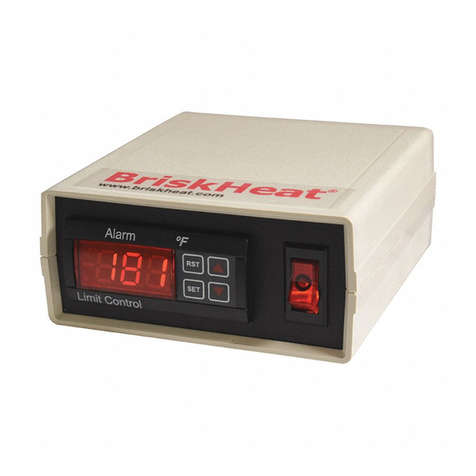
BriskHeat
BriskHeat HL101 Series instruction manual

Euromex
Euromex AE.5168 instruction manual
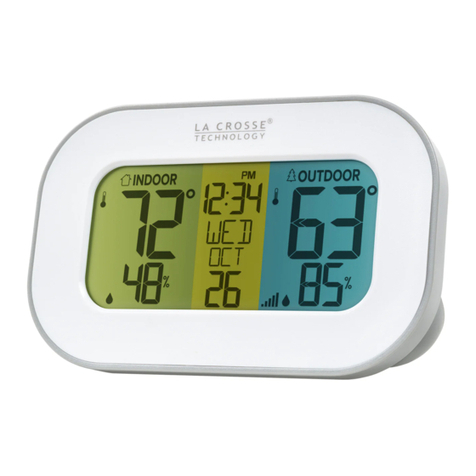
La Crosse Technology
La Crosse Technology CA308148 Setup guide
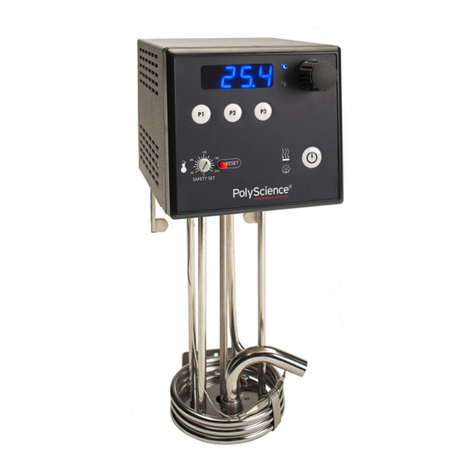
PolyScience
PolyScience Standard Controller Models Operator's manual
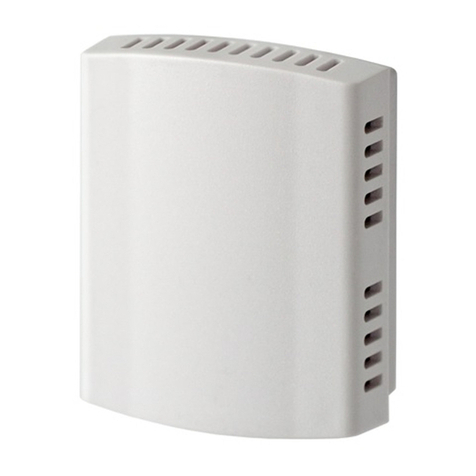
American Standard
American Standard ZZSENSAL0400AA Installer's guide
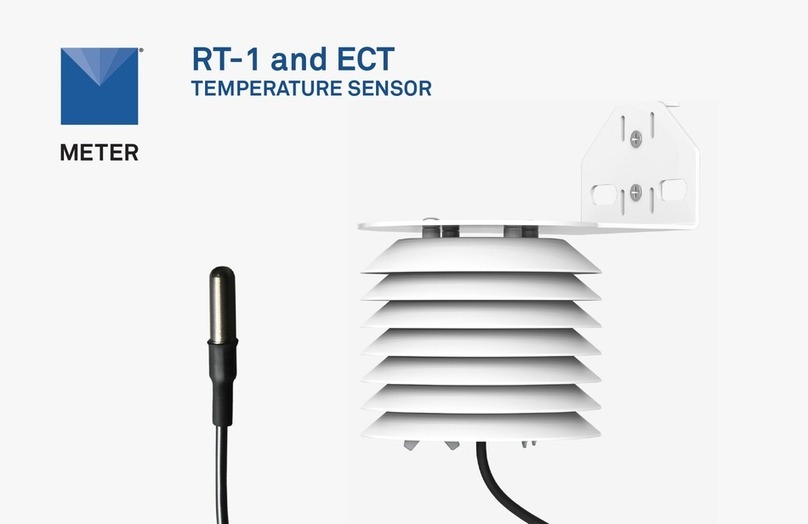
METER
METER RT-1 quick start guide
